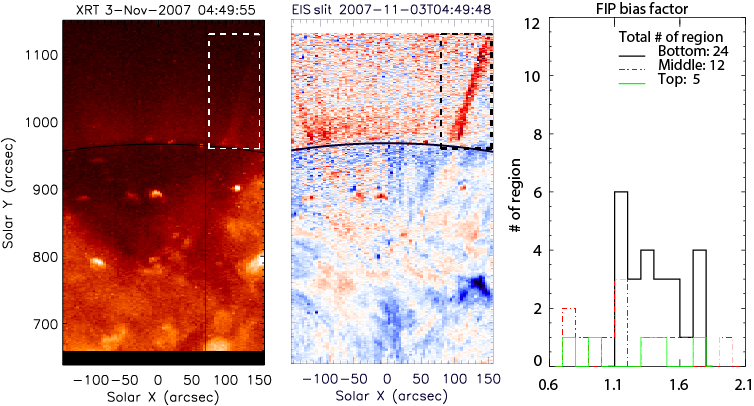
My starting point of Solar EUV spectroscopy!
Lee, Kyoung-Sun(国立天文台 研究員)
「ひのでプロジェクト」に参加したのはいつですか?そのきっかけは?
I joined the Hinode project team as a postdoctoral researcher from 2013 in ISAS/JAXA. But, actually, I had started to use the Hinode data since 2008. There was an SOKENDAI Asian solar physics winter school in NAOJ 2008, and I could learn Hinode data analysis.
私がひのでプロジェクトに参加したのは、2013 年に ISAS/JAXA のプロジェクト研究員になったときです。実際には、2008 年からひのでのデータを使っています。2008 年に総研大アジア冬の学校
が国立天文台であり、ひのでのデータ解析を勉強しました。
「ひのでプロジェクト」の10 年間でいち押しの成果や画像は?
My favorite result with Hinode is the study of abundances of polar X-ray jets, which is one of the candidates of fast solar wind. We found that the polar jets have a photospheric abundance mostly using the Hinode XRT and EIS observations. The result is consistent with the in situ measurement of fast solar wind abundances, and then it confirmed that polar X-ray jets could be source regions of the fast solar wind.
私の好きな成果は極域 X 線ジェットにおける組成比の研究です。X 線ジェットは高速太陽風の源の候補と考えられています。ひので XRT や EIS の解析によってX 線ジェットは光球の組成比になってい
ることを発見しました。 この結果は高速太陽風のその場観測と整合しており、極域 X 線ジェットが高速太陽風の源である可能性を強く裏付けています。
「ひのでプロジェクト」の 10年間で一番印象に残っている出来事や苦労したことは?
I'm doing a chief observer and chief planner for the Hinode/EIS, which is making a planning for the solar observation. When I was a student, I just used the data, which has become public in the web. The chief observer work was a good experience and it makes me understand the data process for the EIS data. One more thing was that I could see how to perform the CCD bake-out for the EIS using the real time command. It was interesting and was helpful for understanding the EIS hardware system.
私は EIS のチーフオブザーバーやチーフプランナーとして太陽観測計画を立てる仕事をしています。学生のときは Webで公開されているデータを使うだけでしたが、チーフオブザーバーの仕事をすることで、EIS のデータがどのように処理されているか学ぶことができました。EIS の CCD カメラをベークアウトするコマンド運用も見ることができました。このような経験を通して、EIS の観測装
置システムの中身を学ぶことができました。
「ひので」で今後取り組みたいことや期待することは?
I would like to study two things using the Hinode/EIS observation. One is the study about the plasma properties for the eruptive and non-eruptive flaring active region using the Hinode EIS data for the space weather forecast. And another is the study of the temperature variation in EUV with solar cycle variation using the 10 years Hinode EIS synoptic data. Those studies can be helpful to understand the solar effect to the space weather and earth climate.
EIS の観測を使って 2 つのことを研究したいと考えています。1 つは、宇宙天気予報のため、爆発を起こす活動領域と起こさない活動領域のプラズマの性質の違いを研究することです。もう 1 つは 10年にわたる EIS の極端紫外線データを使って、コロナ温度の長期的変化を調べることです。このような研究は、宇宙天気や地球の気候に太陽活動がどう影響しているかを理解することに役立ちます。
当ページの画像、映像のご利用については、こちらをご覧ください。当ページの画像、映像でクレジットが明記されていないもののクレジットは『国立天文台/JAXA』です。当ページ内の、クレジットが『国立天文台/JAXA』、『国立天文台/JAXA/MSU』および『国立天文台、JAXA、NASA/MSFC』である著作物については、国立天文台が単独で著作権を有する著作物の利用条件と同様とします。著作物のご利用にあたっては、クレジットの記載をお願いいたします。なお、報道機関、出版物におけるご利用の場合には、ご利用になった旨を事後でも結構ですのでご連絡いただけますと幸いです。ご連絡はsolar_helpdesk(at)ml.nao.ac.jp((at)は@に置き換えてください)にお願いいたします。

